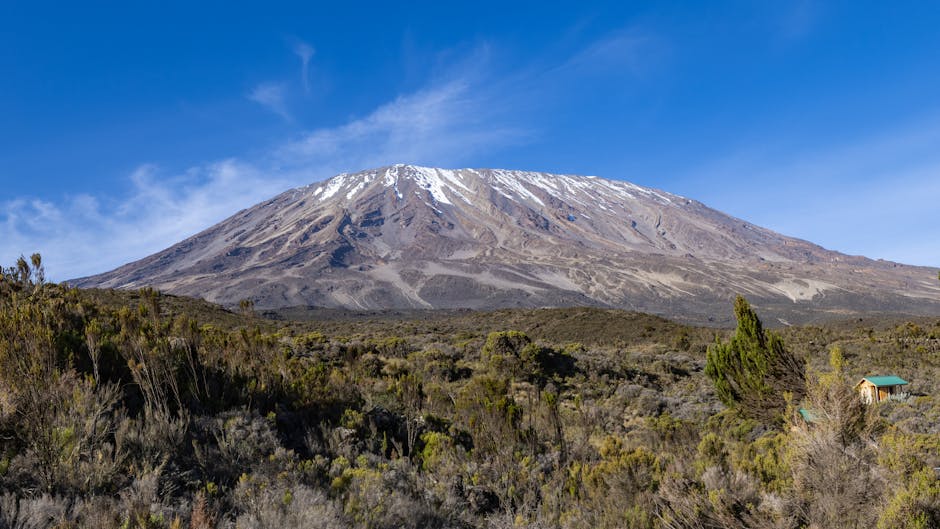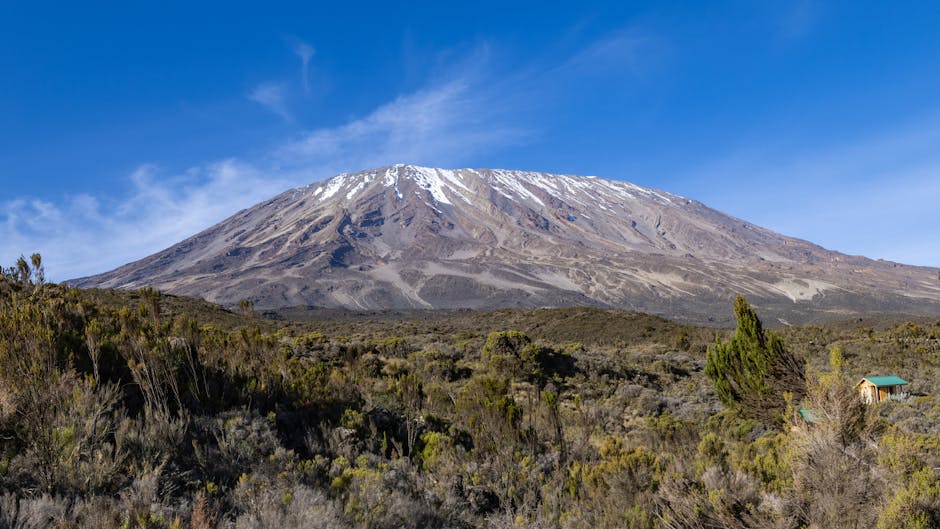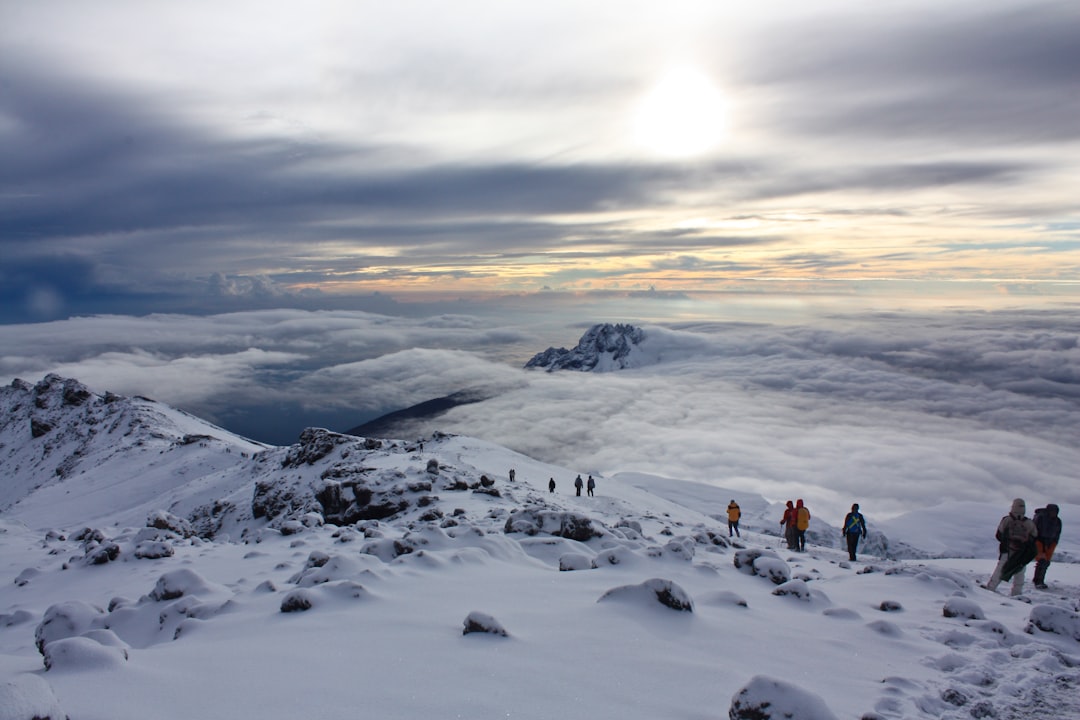

Written by


Mount Kilimanjaro: Insights into Africa’s Tallest Mountain
If you’re looking to learn about Kilimanjaro Mountain, here’s what you need to know in a nutshell:
Mount Kilimanjaro is not just a mountain; it’s a symbol of challenge, adventure, and natural beauty. Standing tall in Tanzania, this majestic peak draws thousands of travelers and trekkers each year, eager to experience its snow-capped summit, diverse ecological zones, and the breath-taking landscapes that lie beneath. Whether you’re an experienced climber looking for your next big adventure, or a curious traveler captivated by the allure of Africa’s tallest peak, Kilimanjaro has something special to offer. In this introduction, we’ll briefly explore the essential facts about Kilimanjaro, setting the stage for a deeper dive into its geographical, historical, and environmental significance.

Location: Kilimanjaro Mountain stands tall in northeastern Tanzania, near the border with Kenya. This giant is not just Africa’s tallest peak but also one of the most iconic landmarks on the continent. Its presence is a beacon for adventurers and nature lovers worldwide.
Tanzania: The country is home to this majestic mountain, offering a rich tapestry of culture, wildlife, and landscapes. Kilimanjaro is a crown jewel in Tanzania’s treasure chest of natural wonders, sitting comfortably among the Serengeti, Ngorongoro Crater, and Zanzibar.
Stratovolcano: Kilimanjaro is a stratovolcano, a term that might sound complex but simply means it’s built up of many layers (strata) of hardened lava, tephra, pumice, and ash. Unlike the explosive reputation of some volcanoes, Kilimanjaro’s story is one of slow, majestic growth, contributing to its towering height and breathtaking beauty.
Free-standing Mountain: What makes Kilimanjaro truly unique is its status as the world’s largest free-standing mountain. It rises dramatically from the surrounding plains, standing alone without a range to support it. This isolation makes its towering presence even more remarkable, visible from miles around and creating a stunning silhouette against the sky.
Kilimanjaro’s geographical significance goes beyond just its physical attributes. It’s a symbol of challenge, adventure, and natural beauty, drawing people from across the globe to experience its majesty. Whether you’re an avid climber, a lover of nature, or simply someone who appreciates the grandeur of our planet, Kilimanjaro has a way of capturing hearts and inspiring dreams.
We’ll delve into the rich history of Kilimanjaro, exploring its first ascent, its status as a UNESCO World Heritage site, and the legends of the Chagga people who have called its slopes home for centuries.
Kilimanjaro Mountain isn’t just a marvel of nature due to its towering height and stunning vistas. Its history is as layered and fascinating as its geological strata. Let’s peel back some of these layers to understand more about this iconic peak.
The journey to the summit of Kilimanjaro is a tale of human ambition and exploration. On October 6, 1889, Hans Meyer, a German geographer, and Ludwig Purtscheller, an Austrian mountaineer, became the first known people to reach the highest point of Kilimanjaro, Uhuru Peak. Their success was the result of Meyer’s third attempt, proving that with perseverance, reaching the top was possible. They were guided by Yohani Kinyala Lauwo, a local Chagga guide whose knowledge of the mountain was invaluable. This historic ascent marked Kilimanjaro as a beacon for adventurers worldwide.
In recognition of its universal value and the need to preserve its beauty for future generations, Kilimanjaro National Park was declared a UNESCO World Heritage Site in 1987. The designation highlights the mountain’s unique ecological systems, its role as a haven for endangered species, and its breathtaking natural beauty. The park encompasses the entire mountain above the tree line as well as the montane forest belt, which is rich in biodiversity. This status not only helps in conserving the fragile ecosystems of Kilimanjaro but also in ensuring that the awe it inspires can be experienced by people from all corners of the globe.
The slopes of Kilimanjaro are steeped in the legends of the Chagga people, who have lived in its shadow for centuries. The mountain, known to them as “Kilema Kyaro,” meaning “that which cannot be conquered” or “that which makes a journey impossible,” is a sacred place, intertwined with their culture and history. The Chagga have long revered the mountain, respecting its power and the life it sustains. Their stories and practices offer a glimpse into the deep relationship between humans and the natural world, reminding us of the respect and awe that Kilimanjaro commands.
As we continue our exploration of Kilimanjaro, we’ll look at the practicalities and challenges of climbing this majestic mountain. From the routes you can take to the physical and mental preparation needed, climbing Kilimanjaro is an adventure that requires planning, respect for the environment, and an understanding of the mountain’s unique challenges.
Climbing Kilimanjaro Mountain is more than just a hike; it’s an adventure that brings you face to face with some of the most breathtaking landscapes on Earth. Let’s dive into the essentials of making this climb a success.
Kilimanjaro offers several routes to its summit, each with its unique scenery and challenges. The Marangu Route, also known as the “Coca-Cola” route, is the most popular. It’s considered the easiest path because it provides hut accommodations. The Machame Route is more scenic but also more challenging, with steeper paths and tented accommodations. For those seeking solitude, the Rongai Route approaches from the north and offers a quieter, more gradual climb. The Lemosho and Shira Routes are known for their beauty and start at higher elevations, offering stunning views from day one. Each route has its pros and cons, but all lead to the awe-inspiring summit of Kilimanjaro.
One of the most appealing aspects of Kilimanjaro is that reaching its summit, Uhuru Peak, doesn’t require any technical climbing skills. Unlike other high peaks, you won’t need ropes, harnesses, or climbing gear. Kilimanjaro is a trekking mountain, making it accessible to anyone in good health and with a strong spirit of adventure. However, don’t let the lack of technical requirements deceive you; the climb is still a serious undertaking.
While you don’t need to be an elite athlete to climb Kilimanjaro, a reasonable level of fitness is crucial. The trek involves long days of walking, often on steep and uneven terrain. Training before your climb can make a significant difference in your experience and success rate. Focus on cardio, leg strength, and endurance exercises. The better your fitness, the more you’ll enjoy the journey.
Perhaps the most critical aspect of climbing Kilimanjaro is acclimatization to the high altitude. Kilimanjaro’s peak is at a lofty 5,895 meters (19,341 feet), where the air is thin, and oxygen levels are low. Proper acclimatization takes time, which is why routes vary in length, typically from 5 to 9 days. Longer routes have higher success rates because they allow more time for your body to adjust to the altitude, reducing the risk of Acute Mountain Sickness (AMS).
Acclimatization Tips:
Climbing Kilimanjaro is an unforgettable experience that challenges your body and spirit. By selecting the right route, preparing physically, and allowing time for acclimatization, you’ll increase your chances of a successful and enjoyable climb. The journey to Uhuru Peak is not just about reaching the summit; it’s about embracing the adventure, the landscapes, and the personal growth that comes with it.
As we continue our journey, let’s explore the environmental concerns surrounding Kilimanjaro and the conservation efforts in place to protect this iconic mountain for future generations.
One of the most visible signs of environmental change on Kilimanjaro Mountain is the glacier retreat. Over the last century, the glaciers atop Kilimanjaro have dramatically reduced in size. Studies, such as those by Thompson et al. (2009), reveal that the ice cap covering the mountain has been shrinking at an alarming rate, with more than 80% of the glacier volume lost. This isn’t just a local issue; it’s a global concern that highlights the impact of climate change on our planet’s natural wonders.
Climate change is the big challenge facing Kilimanjaro. Even though there hasn’t been a clear warming trend at the elevation of Kilimanjaro’s glaciers between 1948 and 2005, other factors like decreased humidity are contributing to glacier shrinkage. This situation mirrors the global crisis where glaciers worldwide are retreating due to changes in the climate, making it imperative for the global community to take action against climate change more aggressively.
In response to these environmental concerns, conservation efforts have been ramped up to protect Kilimanjaro’s unique ecosystems. Kilimanjaro National Park, established in 1973, plays a crucial role in these efforts. Initially, the park was created to protect the area above the tree line and six forest corridors. Over time, with the recommendation of the World Heritage Committee, the park expanded to include more montane forest areas, enhancing the integrity and protection of Kilimanjaro’s diverse habitats.
The park’s management plan focuses on protecting the visual and natural integrity of Kilimanjaro. This includes maintaining the aesthetic quality of the mountain as a spectacular natural site and safeguarding its ecosystems from threats such as invasive species, fire, and climate change. The management also emphasizes the importance of research, monitoring, and education programs to integrate park management with the needs and involvement of surrounding communities.
Tourism, while a significant source of revenue and awareness, poses its challenges. Careful planning and management of tourism-related infrastructure and activities are essential to minimize human impact on the mountain’s fragile ecosystems. Kilimanjaro National Park authorities work tirelessly to balance visitor experience with conservation priorities, ensuring that the mountain remains a source of wonder for generations to come.
In conclusion, the battle to preserve Kilimanjaro Mountain is ongoing. The efforts of park authorities, combined with global action against climate change, are vital to safeguarding this iconic peak. As we marvel at the beauty and challenges of Kilimanjaro, let’s also remember our collective responsibility to protect and preserve our planet’s natural treasures.
In the next section, we’ll dive into the unique aspects of Kilimanjaro, from its equatorial glaciers to its rich biodiversity, and explore why this mountain continues to captivate the imagination of adventurers and conservationists alike.
Kilimanjaro Mountain isn’t just another peak; it’s a world of its own. From icy glaciers at the equator to lush rainforests teeming with life, Kilimanjaro is a place of magic and mystery. Let’s explore what makes this mountain so special.
Imagine standing close to the equator, where you’d expect a warm climate, and then finding yourself next to a glacier. That’s Kilimanjaro for you. Despite being just 205 miles from the equator, Kilimanjaro’s summit is crowned with ice. These glaciers are a rare sight and have puzzled scientists and explorers for years. However, they’re vulnerable to climate change, with significant retreat observed over the years.
Kilimanjaro isn’t just one mountain; it’s three. Kibo, Mawenzi, and Shira are volcanic cones that make up this giant. Kibo is where you’ll find the highest peak, Uhuru Point. Mawenzi adds to the rugged skyline with its jagged peaks, while Shira is more of a plateau, remnants of an ancient volcano. Together, they tell the story of Kilimanjaro’s fiery past.
Kilimanjaro is a haven for biodiversity. As you climb, you’ll move through different worlds, from lush rainforests filled with chattering monkeys and colorful birds to the alpine desert where hardy plants cling to life. Each zone is a unique ecosystem, home to species that have adapted to thrive in these specific conditions. The mountain is a crucial refuge for endangered species, including elephants and buffaloes, which roam the lower slopes.
Kilimanjaro offers a journey through five ecological zones, each with its own climate, plants, and animals. Starting with the Cultivation Zone, where local communities grow crops on the fertile volcanic soils. Then, the Rainforest Zone, a moist, green world that acts as the lungs of the mountain. Above that is the Heath and Moorland Zone, where giant heathers and lobelias dominate the landscape. The Alpine Desert Zone surprises many with its stark beauty and wide temperature swings. Finally, the Arctic Zone at the summit, a world of ice and snow, where few life forms can survive.

Each of these aspects – the equatorial glaciers, the volcanic cones, the rich tapestry of flora and fauna, and the distinct ecological zones – make Kilimanjaro a truly unique place on Earth. It’s not just the height that makes Kilimanjaro a marvel; it’s the journey through these diverse worlds, all on one mountain, that leaves a lasting impression on those who visit.
In the next section, we’ll answer some of the most frequently asked questions about Kilimanjaro, from the best time to climb to the challenges you might face on your journey to the roof of Africa.
The best times to climb Kilimanjaro Mountain are during its two dry seasons: January to March and June to October.
Climbing Kilimanjaro takes about 6 to 8 days, depending on the route you choose.
The journey is not just about reaching the top but enjoying the incredible landscapes and biodiversity along the way.
Climbing Kilimanjaro presents several challenges:
Despite these challenges, with the right preparation and support from experienced guides like those at Tanzania Tribe Safari, reaching the summit of Kilimanjaro is an achievable dream for many.
In the next section, we will explore Tanzania Tribe Safari and how they can help make your Kilimanjaro adventure unforgettable.
Climbing Kilimanjaro Mountain is not just about reaching the highest point in Africa. It’s a journey that tests your limits, introduces you to breathtaking landscapes, and connects you with fellow adventurers from around the globe. It’s a story you’ll tell for years, filled with challenges, triumphs, and the sheer beauty of nature.
At Tanzania Tribe Safari, we understand the magnitude of this adventure. We’re more than just a travel company; we’re your partners in making this journey safe, enjoyable, and unforgettable. Our team of expert guides, porters, and staff are dedicated to providing you with an unparalleled climbing experience.
Why Choose Us for Your Kilimanjaro Adventure?
Climbing Kilimanjaro is an extraordinary undertaking. It’s not just about physical endurance but also about embracing the journey, learning from the mountain, and creating memories that last a lifetime. With Tanzania Tribe Safari, you’re not just climbing a mountain; you’re embarking on an adventure that will challenge, inspire, and transform you.
Ready to start planning your Kilimanjaro adventure? Explore our Mount Kilimanjaro Climbing tours and let’s make your dream climb a reality. Kilimanjaro awaits. Together, let’s reach new heights.
Climbing Kilimanjaro Mountain with Tanzania Tribe Safari is more than a journey; it’s an experience that will stay with you forever. Let us guide you to the roof of Africa.
Mar 29, 2024



Tanzania Tribe Safari is an exceptional organization focused on delivering a customized Tanzanian experience to its customers. I highly recommend them to anyone interested in traveling to Tanzania in search of a one-of-a-kind experience.
The trip of a lifetime! Tanzania Tribe Safari created a seamless experience for us from wonderful hotels and a tented camp to a safari experience that kept us in awe. Our safari guide Amini wore many hats during our trip and had eyes of an eagle!
Oh my gosh! Where do I start? My three sisters and I booked a trip to Tanzania and Zanzibar through Tanzania Tribe Safari. It can be marked as a trip of a lifetime! Our safari guide, Amini was very knowledgeable about the animals and terrain.